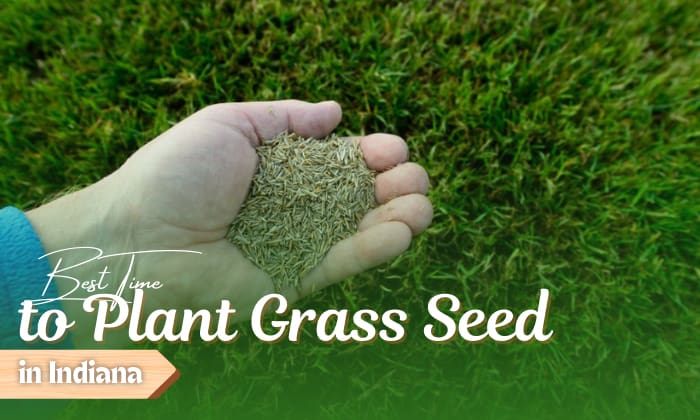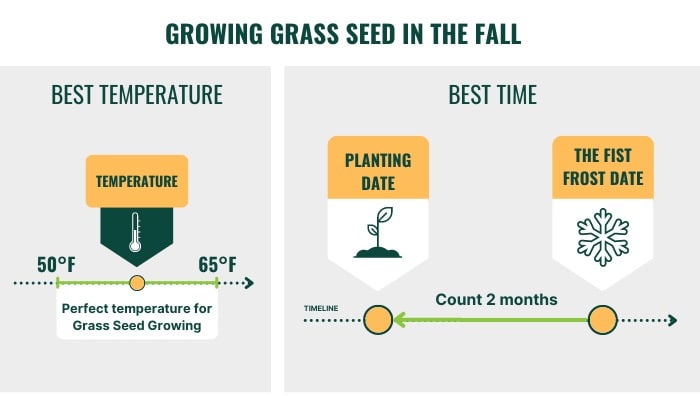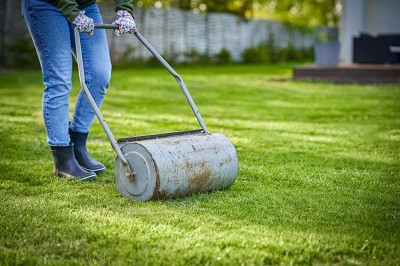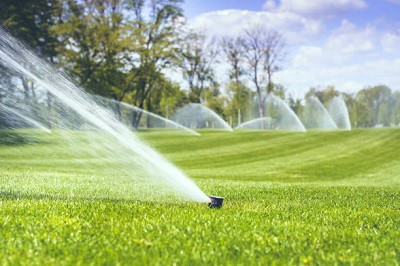It’s essential to determine when to plant grass seed in Indiana before starting a new lawn in the state.
Because cool-season grasses suit IN’s climate the most, early fall is the best time of year for planting turfgrass rather than spring, though spring can bring successful results as well, to a lesser extent.
In practice, Labor Day or late August to early October is the ideal fall gardening schedule, with March to May being a practical alternative for those who want to overseed lawn or spruce up their thin, damaged turf after winter.
Read below for more tips on sowing grass seeds.
Table of Contents
Best Time to Plant Grass Seed in Indiana
1. In the fall, two months before the first frost
How late can you seed grass in the fall?
While determining your planting schedule, count backward two months from the first frost to get your gardening date.
At the same time, sow grass seeds in Indiana when soil temperatures measure 50 to 65℉.
This level of warmth is conducive to root establishment, and along with the lack of pressure from lawn weeds during the fall, your grass seedlings will have ample time to strengthen themselves and prepare for winter dormancy.
Since Indiana zone for plants consists of hardiness zone 5 and 6, we’ve estimated the gardening dates for each one below.
| Growing zone | Average first frost | Estimated planting date |
| Zone 5 (northern Indiana) | October 21 | August 21 |
| Zone 6 (mostly in southern Indiana) | October 31 | August 31 |
2. In the spring, from the first week of March to mid-May
A rule of thumb for sowing grass seeds in spring is to grow them on the last snow. However, it is impossible to accurately predict when this date would be, so it’s more practical to plant grass seeds from the first week of March to mid-May instead.
We recommend planting grass before the ground thaws, around Thanksgiving to late March.
As the soil warms up, it will form cracks that push the seeds down and keeps them from being blown off. In practice, you can also pick April and May as your grass seed time, but earlier planting will produce better results.
- It’s vital to note that spring planting is suboptimal compared to fall planting, since the melting snow and intermittent rains during spring make seed rotting or wastage through flooding more likely.
- The damp and cold environment also hinders germination, which is why spring gardening should be reserved for very thin, damaged lawns or new home renovation.
The best grass seed for overseeding is either tall fescue or perennial ryegrass. Do not use Kentucky bluegrass in spring, unless you mix it with perennial ryegrass or fescue following an 8:2 or 1:9 ratio.
See now the best time to plant Kentucky bluegrass.
Tips for Growing Grass Seed Successfully in Indiana
1. Prepare the soil before overseeding
Trim the current grass to 1.5 inches and loosen the soil with a Garden Weasel before overseeding your lawn. Afterward, apply a high-phosphate starter fertilizer, sow grass seeds, and rake the ground so that the seeds are buried at a depth of ¼ inch.
Lightly step on the seeding area with your feet to compress the soil, then apply peat moss to the planting location if you want.
2. Follow the proper steps for seeding new lawns
Clear away all debris, weeds, and other vegetation from your yard with a shovel. If using a herbicide, follow package instructions for the application method and waiting time before seeding.
Similar to patching up old lawns, loosen the soil by digging and smoothen it by walking over the planting medium with a roller.
It’s also vital to rake the ground and spread three to four centimeters of lawn-seeding soil onto it.
Then level the planting area with a rake again before spreading seeds two times while going in opposite directions (east to west and north to south, for example).
3. Care for the seeds after planting
Use a watering can or sprinkler to irrigate the soil daily and help seeds establish. Avoid using a hose, as the high water pressure can move or wash away the germinating seeds.
As mentioned above, the temperature to plant grass is around 50 to 55℉, which will enable quick germination as long as the top ½ inch of the soil doesn’t dry out.
You can reduce the watering frequency to once every two days when grass shoots appear, all while ensuring they receive six hours of light per day.
Indiana has largely well-drained soil with adequate fertility, but applying an inch of compost before planting and an N-P-K fertilizer six weeks after germination will still be beneficial.
Conclusion
We hope this article presented useful facts regarding when to plant grass seed in Indiana.
Aside from having an appropriate grass planting schedule, you should pick cool-season turf varieties like fine fescue and perennial ryegrass. These are ideal for Indiana’s cold climate and will ensure the highest chance of establishing a lush lawn.

Hi, I am William – Floridayards’ digital content creator. My job is to find answers to all your concerns with thorough research and our team’s expert advice. I will also bring you honest reviews on the best products and equipment for raising your beautiful garden. Please look forward to our work!
















